Installing and Configuring the SteelFusion Edge Appliance (iSCSI/Block Mode)
This chapter describes how to install and configure the SteelFusion Edge appliance in iSCSI/block mode. It includes these sections:
Read and follow the safety guidelines described in the Safety and Compliance Guide. Failure to follow these safety guidelines can result in damage to the equipment.
For detailed information about installing the appliance to a rack, see the SteelFusion Edge Hardware and Maintenance Guide.
Deploying the SteelFusion Edge appliance
You deploy the Edge appliance in a physical in-path or virtual in-path deployment. This guide describes how to install the Edge appliance in an in-path deployment.
Position your Edge appliances as close as possible to your network endpoints—that is, branch office Edge appliances should be as close to your clients as possible, and data center SteelFusion Cores should be as close to your storage arrays as possible to maximize performance and minimize latency.
Ideally, Edge appliances optimize only traffic that is initiated or terminated at their local site. We recommend that you deploy the Edge appliances where the LAN connects to the WAN, and not where any LAN-to-LAN or WAN-to-WAN traffic can pass through (or be redirected to) the Edge appliance.
For detailed information about your deployment options and best practices for deploying Edge appliances, see the SteelFusion Design Guide.
Figure 3‑1. SteelFusion Edge in-path deployment
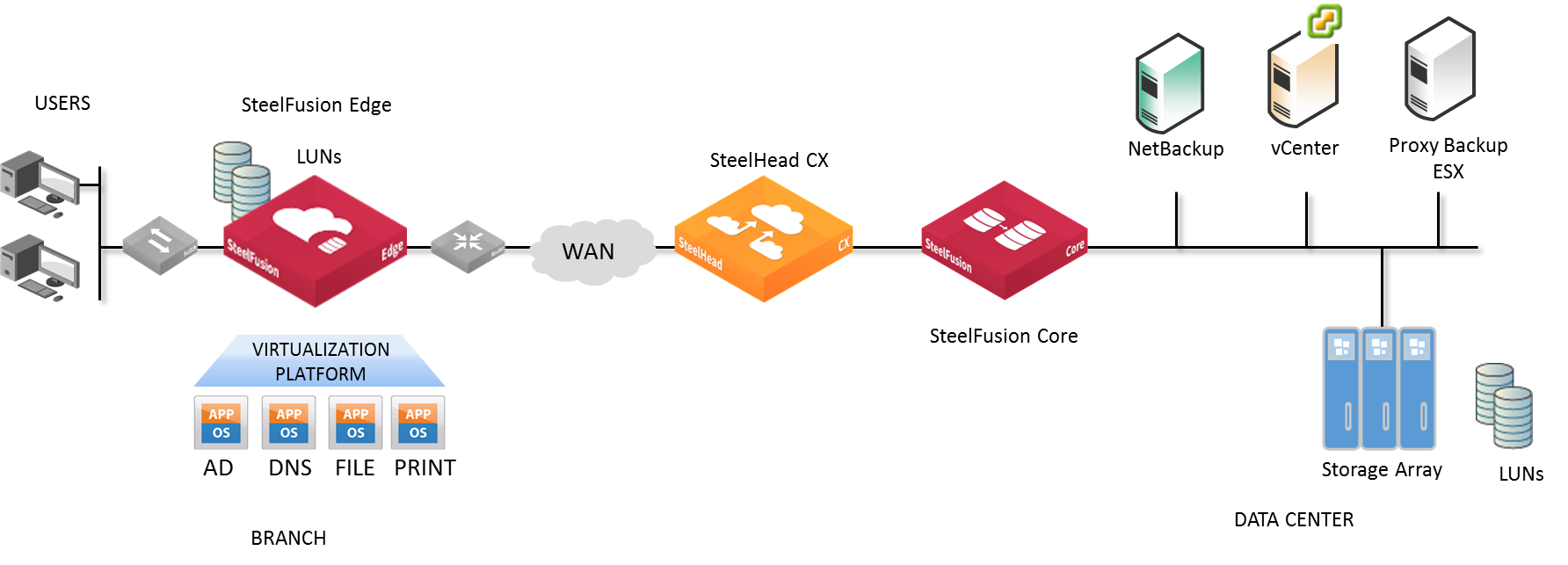
You can also deploy the Edge appliance for high availability (HA) where Edge and Core appliances are deployed as pairs so that if either peer fails, the surviving Edge or Core appliances can take over. We strongly recommend that you deploy Edge appliances as pairs in an HA cluster configuration. For detailed information about HA, see the SteelFusion Edge User Guide and the SteelFusion Design Guide.
Figure 3‑2. SteelFusion Edge high availability deployment

Checking your inventory
Your shipping carton contains these items:
n The Edge appliance
n One standard Ethernet straight-through cable
n One standard Ethernet crossover cable
n One serial null-modem cable
n One or two power cables (depending on your order)
Aside from country-specific requirements, all appliances ship with the same power cable. The power cable has an IEC 60320 C13 plug on one end (to connect to the Edge appliance) and a country-specific plug that fits the wall socket for that country. If the appliance has two power supplies, it ships with two suitable cables.
You must always connect the Edge appliance using either the cable in the accessories box or another cable that is approved for use by the IEC in the country in which the appliance is connected.
You cannot connect the Edge appliance directly to multiphase outlets. You must use a rack power distribution unit (PDU) or power strip that provides the appropriate three-prong outlet (hot/neutral/ground). For details, see the Knowledge Base
solution number S13425.
n One Phillips screwdriver
n Rails
n One mounting kit
n Documentation kit
If any items are damaged or missing, notify Riverbed Support at
https://support.riverbed.com for replacement or repair.
Preparing your site for installation
The Edge appliance ships completely assembled, with all the equipment parts in place and securely fastened.
Site requirements
Before you install the Edge appliance, make sure that your site meets these requirements:
n It is a standard electronic environment where the ambient temperature does not exceed 104ºF (40ºC) and the relative humidity does not exceed 80% (noncondensing). For detailed information, see the SteelFusion Edge Hardware and Maintenance Guide.
n Ethernet connections are available within the standard Ethernet limit.
n There is available space on a two-post or four-post 19-inch rack. For details about installing the Edge to a rack, see the Rack Installation Guide or the printed instructions that were shipped with the appliance.
n A clean power source is available, dedicated to computer devices and other electronic equipment.
n The rack is a standard 19-inch Telco-type mounting rack.
Before you begin, consult the SteelFusion Edge Hardware and Maintenance Guide for detailed information about how to install your model to a rack.
We recommend that you use a four-post mounting rack for 2U appliances.
If your rack requires special mounting screws, contact your rack manufacturer.
SteelFusion Edge ports
This table summarizes the ports that connect the Edge appliance to your network.
Port | Description |
PRI
(Primary) | The primary port connects the Edge appliance to a LAN switch. This interface enables you to connect to the Edge Management Console and the SteelFusion Edge CLI. This interface can also be used to connect the SteelFusion Core through the RiOS node, in-path interface. The primary and auxiliary ports cannot share the same network subnet. |
AUX
(Auxiliary) | The auxiliary port provides an additional management interface to a secondary network such as a management VLAN. You can connect a computer directly to the appliance with a crossover cable, enabling you to access the CLI or Management Console. To use external IPMI access for 1U and 2U appliances, the AUX port must be enabled. IPMI access does not require the AUX port to have an IP address configured but it does require that the port is enabled. Disabling AUX disables remote management; enabling remote management without enabling AUX leaves remote management inaccessible. You enable the AUX port in the Management Console or the CLI. For detailed information about connecting and monitoring the appliance using the BMC, see the SteelFusion Edge Hardware and Maintenance Guide. |
LAN 1_0 (1U)
LAN 0_0 (2U) | This port connects the LAN port of the Edge appliance to the LAN switch using a straight-through cable. The Edge appliance uses one or more in-path interfaces to provide Ethernet network connectivity for optimized traffic. Each in-path interface comprises two physical ports: the LAN port and the WAN port. Use the LAN port to connect the Edge appliance to the internal network of the branch office. If the Edge appliance is deployed between two switches, both the LAN and WAN ports must be connected with straight-through cables. |
WAN 1_0 (1U)
WAN 0_0 (2U) | This port connects the WAN port of the Edge appliance to the WAN router using a crossover cable. The WAN port is the second of two ports that compose the in-path interface. The WAN port is used to connect the Edge appliance toward WAN-facing devices such as a router, firewall, or other equipment located at the WAN boundary. If you require additional in-path interfaces or require 10GigE or Fiber connectivity, you can install a bypass NIC in the RiOS node expansion slot. |
eth0_0, eth0_1 | These ports provide additional iSCSI interfaces for storage traffic to external servers when used by the RiOS node. The ports are connected to a LAN switch using a straight-through cable. These ports can also provide multipath I/O (MPIO) redundancy or SteelFusion Edge high availability (HA). In an HA deployment, use these ports for BlockStream heartbeat and synchronization between SteelFusion Edge HA peers. For detailed information about HA deployments, see the SteelFusion Design Guide. If you require additional iSCSI connectivity in an HA deployment, install a nonbypass NIC in the RiOS node expansion slot. |
gbe0_0, gbe0_1, gbe0_2, gbe0_3 | These 1-Gbps ports provide hypervisor node connectivity. When configured for use by the hypervisor node, these ports provide LAN connectivity to external clients. The ports are connected to a LAN switch using a straight-through cable. If you require additional connectivity for the hypervisor node, you can install a nonbypass NIC in the hypervisor expansion slot. The SteelFusion Edge models 2100 and 2200 do not have additional hypervisor expansion slots. The SteelFusion Edge models 3100, 3200, and 5100 have two hypervisor expansion slots. |
RIOS COM | A RiOS serial RJ45 communication port that manages the RiOS node. Serial settings: 9600 bps, 8 data bit, 1 stop bit, no parity. Connects the serial cable to a terminal device. You establish a serial connection to a terminal emulation program for console access to the configuration wizard and the Edge CLI. |
HYP COM | A hypervisor serial RJ45 communication port used to manage the hypervisor node. Serial settings: 9600 bps, 8 data bit, 1 stop bit, no parity. |
USB 1, USB 2 | Optional Hypervisor universal serial bus (USB) ports. |
VGA | Optional Hypervisor VGA connector. This port is useful for BIOS, POST, and PXE debugging. |
Figure: 1U back panel and
Figure: 2U back panel show the locations of the ports on the rear of the 1U and 2U appliances.
Figure 3‑3. 1U back panel

Figure 3‑4. 2U back panel
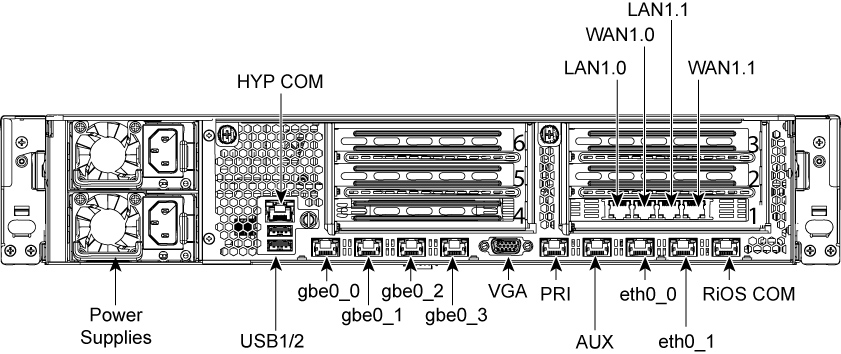
Figure: Typical SteelFusion Edge port connections 1U appliance shows typical branch office connections for the Edge
appliance.
Figure 3‑5. Typical SteelFusion Edge port connections 1U appliance
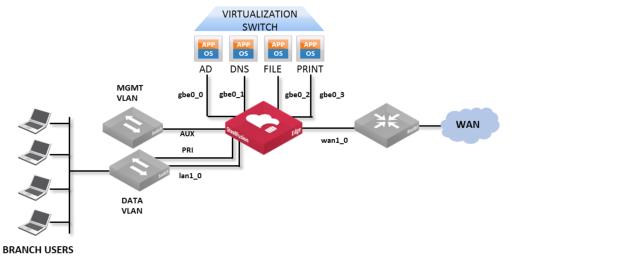
Network interface cards and expansion slots
The 1U appliance is equipped with a preinstalled four-port 1-Gigabit Ethernet copper bypass NIC. The 1U appliance has an additional slot for an add-on NIC for a total of two slots. Both slots are assigned to the RiOS node.
The 2U appliance is equipped with a preinstalled four-port 1-Gigabit Ethernet copper bypass NIC with an integrated LSI expander NIC for bypass support. The 2U appliance has five additional slots for add-on NICs for a total of six slots. Slot 1, 2, 3, and 4 are assigned to the RiOS node, and slots 5 and 6 are assigned to the hypervisor node.
This table summarizes the NIC deployment options for the Edge appliance.
Model | PCI expansion slots | Slot 1 (always populated prior to shipment) | Slot 2
RiOS node | Slot 3 and 4
RiOS node | Slot 5 and 6
hypervisor node |
SFED 2100 | 2 | in-path | in-path or storage | — | — |
SFED 2200 | 2 | in-path | in-path or storage | — | — |
SFED 3100 | 6 | in-path | in-path or storage | in-path or storage | data |
SFED 3200 | 6 | in-path | in-path or storage | in-path or storage | data |
SFED 5100 | 6 | in-path | in-path or storage | in-path or storage | data |
The NIC deployment options are defined as follows:
n in-path - A bypass NIC used by the RiOS node for WAN optimization traffic.
n storage - A multiport data NIC used by the RiOS node, enabling iSCSI access for storage traffic to and from servers external to the Edge appliance, or providing additional heartbeat interfaces in an HA deployment.
n data - A multiport data NIC used by the hypervisor node, enabling LAN access for hypervisor node traffic.
A multiport data NIC can be used for storage or data—it is the slot that determines its function.
For detailed information about installing additional NICs, see the SteelFusion Edge Hardware and Maintenance Guide and the SteelFusion Design Guide.
Avoiding duplex mismatch
Before you begin the configuration process, ensure that your LAN and WAN interfaces have the same duplex settings.
The Edge automatically negotiates duplex settings. If one end of the link is set to autonegotiate and the other end of the link is not set to autonegotiate, the duplex settings on the network device default to half-duplex. This duplex mismatch passes traffic, but it causes late collisions and results in degraded optimization. To achieve maximum optimization, set your network devices to 100 and full.
To avoid duplex mismatches, manually configure the duplex settings on your:
n router.
n switch.
n Edge appliance WAN interface.
n Edge appliance LAN interface.
n Edge appliance primary interface.
These conditions can indicate a duplex mismatch:
n Choose Administration > Diagnostics: System Logs to view the System Logs page, errors for sends, receives, cyclic redundancy check (CRC), and short sends are displayed.
n You cannot connect to an attached device.
n You can connect to a device when you choose autonegotiation, but you cannot connect to that same device when you manually set the speed or duplex.
n Slow performance across the network.
Completing the configuration checklist
This table lists the parameters you specify to complete the initial configuration of the Edge appliance. Be prepared to provide values for these parameters.
Appliance | Parameter | Your value |
SteelFusion Edge (the primary interface) | Hostname | |
IP address | |
Netmask | |
Default gateway (the WAN gateway) | |
DNS IP address | |
Domain name for the appliance | |
Administrator password | |
SMTP server IP address | |
Events and failures notification email address | |
Primary interface speed | |
Primary interface duplex | |
In-path deployments | In-path interface IP address | |
In-path netmask | |
In-path gateway | |
In-path: LAN interface speed | |
In-path: LAN interface duplex | |
In-path: WAN interface speed | |
In-path: WAN interface duplex | |
Powering on the appliance
This section describes how to connect the AC power and how to power on the appliance.
In European electrical environments, you must ground (earth) the green/yellow tab on the power cord or risk electrical shock.
To power on the appliance
1. If your appliance has a master power switch, ensure that it is in the off position.
2. Plug the AC power cord into the appliance.
If your model has multiple power supplies, you must plug in all the power cords or you will hear an alarm.
Figure 3‑6. Connecting the AC power
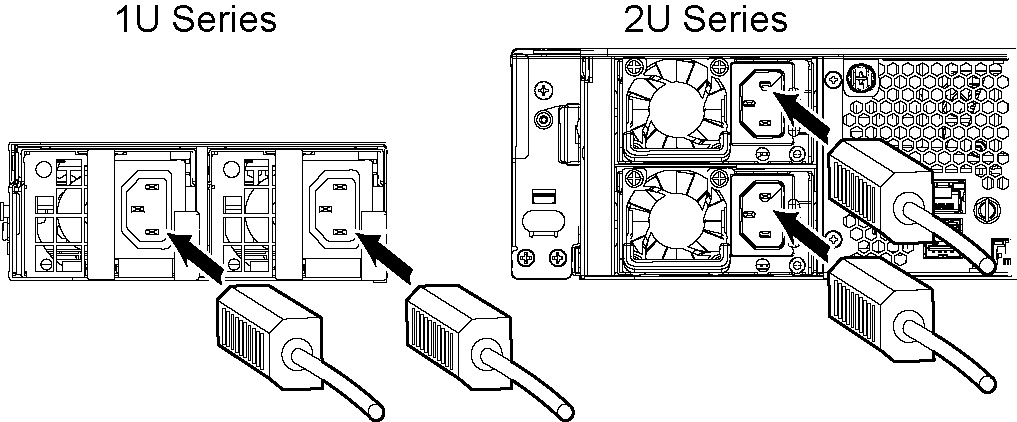
3. Plug the AC power cord into an uninterrupted AC power source.
4. Press the appliance power switch on.
If the Edge appliance does not immediately power on, press the power switch off, and then press the power switch on again.
5. Check the status lights on the appliance.
For detailed information about the status lights, see the SteelFusion Edge Hardware and Maintenance Guide.
Configuring SteelFusion Edge appliances
The Edge appliance is physically in the direct path between clients and servers. The clients and servers continue to see client and server IP addresses.
Connecting the SteelFusion Edge to your network
You use standard Ethernet straight-through and crossover cables to connect to your network in an in-path configuration. This table summarizes the correct cable usage when you are connecting LAN and WAN ports or when you are connecting data ports.
Device | Cable |
Edge appliance to a switch | Straight-through (for example, primary and LAN ports on the appliance to the LAN switch) |
Edge appliance to a router | Crossover (for example, WAN port on the appliance to the WAN router) |
Edge appliance to a host | Crossover (for example, LAN and WAN ports on the Edge appliance bypass cards act like host interfaces during normal operation) |
Edge appliance to an Edge appliance | Crossover (for example, in high availability deployments) |
For detailed information about cabling best practices, see the SteelFusion Design Guide.
To connect the appliance to your network
1. Plug the straight-through cable into the primary port of the appliance and the LAN switch. The primary port can be any port on your LAN switch configured to connect to a host.
Figure 3‑7. Connecting the primary port to the LAN switch

2. Identify the straight-through cable that connects your LAN switch to your WAN router. Unplug the end connected to the WAN router.
Figure 3‑8. Disconnecting the WAN router

3. Plug the straight-through cable that you disconnected from the WAN router into the LAN port of the appliance.
Figure 3‑9. Connecting the LAN switch to the LAN port

4. Using the provided crossover cable, plug the cable into the WAN port of the appliance and the WAN router.
Figure 3‑10. Connecting the WAN port to the WAN router

If you have additional four-port bypass cards, repeat
Step 1 through
Step 4. For detailed information about installing additional bypass cards, see the
Network and Storage Card Installation Guide and the
SteelFusion Edge Hardware and Maintenance Guide.
Connecting virtual machines to the Edge appliance
The Edge appliance supports virtual machines (VMs) on the hypervisor node of the appliance. The ports are labeled gbe0_0, gbe0_1, gbe0_2, and gbe0_3.
To connect the hypervisor to the system
1. Plug the straight-through cable into one of the hypervisor ports: gbe0_0, gbe0_1, gbe0_2, or gbe0_3.
2. Plug the straight-through cable into any switch that is connected to the hypervisor node.
After you complete the configuration process for the Edge appliance, connect to the Management Console to configure your hypervisor using the Hypervisor Installer. You can access the Hypervisor Installer from the Management Console Dashboard or by choosing Virtualization > Installer: Installer. The hypervisor must be installed before you can host VMs.
Before you launch the Hypervisor Installer, if you are using a SteelFusion Core for storage, you should configure and connect it before continuing with the installer. A SteelFusion Core allows you to access remote storage at your data center and make that storage available to your hypervisor. For details, see the SteelFusion Core User Guide.
Running the Configuration Wizard
To access the configuration wizard and the SteelFusion Edge CLI, you establish a serial connection using a terminal emulator program.
To run the configuration wizard
1. Plug the serial cable into the RiOS COM port and a terminal.
Figure 3‑11. Connecting to the SteelFusion Edge
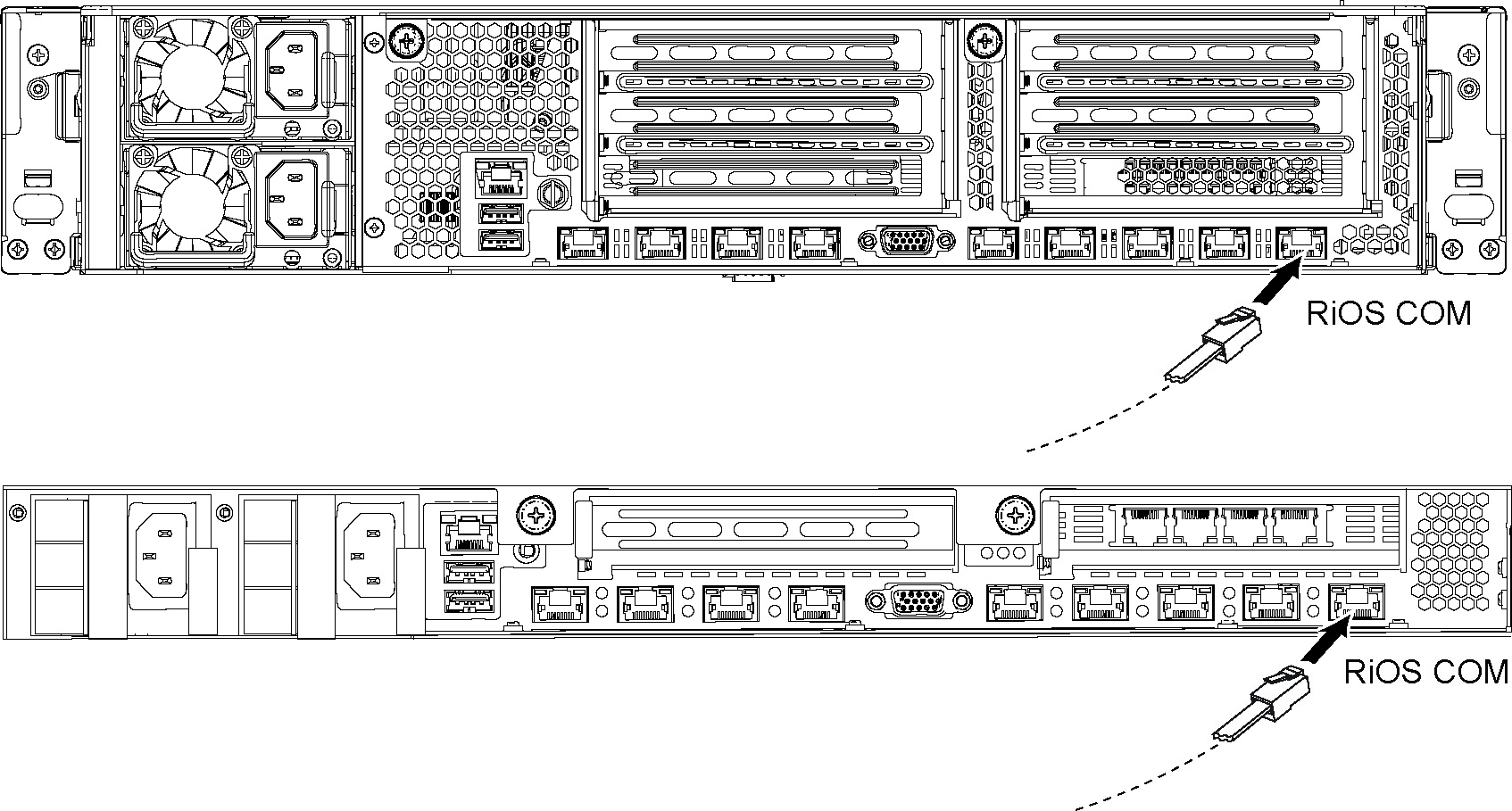
2. Start your terminal emulation program, such as Tera Term Pro. The terminal device must have these settings:
n Baud rate: 9600 bps
n Data bits: 8
n Parity: none
n Stop bits: 1
n vt100 emulation
n No flow control
If you are using the Edge appliance with a terminal server, the terminal server must use hardware flow control for the port connected to the Edge appliance.
We recommend that you connect the console port to a device that logs output to help identify problems with the system.
3. Log in as administrator user (admin) and enter the default password (password). For example:
login as: admin
Sent username "admin"
password: password
The configuration wizard automatically starts after you have entered the login and default password. After you have established a connection, you configure the Edge appliance using the configuration wizard.
4. If you have a SteelCentral Controller for SteelHead (SCC) appliance installed in your network to manage multiple Edge appliances, you can use it to automatically configure them:
Do you want to auto-configure using a SCC? no
If you answer yes, you are prompted for the SCC hostname or IP address. The hostname or IP address is used to contact the SCC. The default value is riverbedcmc. If you enter no, the wizard continues.
5. To start the configuration wizard, type yes at the system prompt and press Enter.
Do you want to use the configuration wizard for initial configuration? yes
Press ? for help; press Ctrl+B to go back to the previous step.
6. Complete the configuration wizard steps on the branch office Edge appliance as described in this table.
Wizard prompt | Description | Example |
Step 1: Host name? | Enter the hostname for the Edge appliance. | hostname? amnesiac |
Step 2: Use DHCP on the primary interface? | You are given the option to enable the DHCP to automatically assign an IP address to the primary interface for the Edge appliance. We recommend that you do not set DHCP. The default value is yes. | Use DHCP? no |
Step 3: Primary IP address? | Enter the IP address for the Edge appliance. | Primary IP address? 10.10.10.6 |
Step 4: Netmask? | Enter the netmask address. | Netmask? 255.255.0.0 |
Step 5: Default gateway? | Enter the default gateway for the Edge appliance. | Default gateway? 10.0.0.1 |
Step 6: Primary DNS server? | Enter the primary DNS server IP address. | Primary DNS server? 10.0.0.2 |
Step 7: Domain name? | Enter the domain name for the network where the Edge appliance is to reside. If you set a domain name, you can enter hostnames in the system without the domain name. | Domain name? example.com |
Step 8: Admin password? | We strongly recommend that you change the default administrator password at this time. The password must be a minimum of six characters. The default administrator password is password. | Admin password? xxxyyy |
Step 9: SMTP server? | Enter the name of the SMTP server. External DNS and external access for SMTP traffic is required for email notification of events and failures to function. Make sure that you provide a valid SMTP server to ensure that the email notifications for events and failures are sent to the correct destinations. | SMTP server? natoma |
Step 10: Notification email address? | Enter a valid email address to which notification of events and failures are to be sent. | Notification email address? example@xample.com |
Step 11: Set the primary interface speed? | Enter the speed on the primary interface (that is, the Edge appliance). Make sure that this value matches the setting on your router or switch. The default value is auto. | Set the primary interface speed? [auto] auto |
Step 12: Set the primary interface duplex? | Enter the duplex mode on the primary interface. Make sure that this value matches the setting on your router or switch. The default value is auto. | Set the primary interface duplex? [auto] auto |
Step 13: Would you like to activate the in-path configuration? | Enter yes at the system prompt to configure in-path support. An in-path configuration is a configuration in which the Edge appliance is in the direct path of the client and server. | Would you like to activate the in-path configuration? yes |
Step 14: In-Path IP address? | Enter the in-path IP address for the Edge appliance. | In-Path IP address? 10.11.11.6 |
Step 15: In-Path Netmask? | Enter the in-path netmask address. | In-Path Netmask? 255.255.0.0 |
Step 16: In-Path Default gateway? | Enter the in-path default gateway (the WAN gateway). | In-Path Default Gateway? 10.11.11.16 |
Step 17: Set the in-path: LAN interface speed? | Enter the in-path, LAN interface speed. Make sure that this value matches the setting on your router or switch. The default value is auto. | Set the in-path: LAN interface speed? [auto] auto |
Step 18: Set the in-path: LAN interface duplex? | Enter the in-path, LAN duplex value. Make sure that this value matches the setting on your router or switch. The default value is auto. | Set the in-path: LAN interface duplex? [auto] auto |
Step 19: Set the in-path: WAN interface speed? | Enter the in-path, WAN interface speed. Make sure that this value matches the setting on your router or switch. The default value is auto. | Set the in-path: WAN interface speed? [auto] auto |
Step 20: Set the in-path: WAN interface duplex? | Enter the in-path, WAN duplex speed. Make sure that this value matches the setting on your router or switch. The default value is auto. | Set the in-path: WAN interface duplex? [auto] auto |
The system confirms your settings.
You have entered the following information:
1. Hostname: amnesiac
2. Use DHCP on primary interface: no
3. Primary IP address: 10.10.10.6
4. Netmask: 255.255.0.0
5. Default gateway: 10.0.0.1
6. Primary DNS server: 10.0.0.2
7. Domain name: example.com
8. Admin password: xxxyyy
9. SMTP server: natoma
10. Notification email address: example@example.com
11. Set the primary interface speed: auto
12. Set the primary interface duplex: auto
13. Would you like to activate the in-path configuration: yes
14. In-Path IP address: 10.11.11.6
15. In-Path Netmask: 255.255.0.0
16. In-Path Default gateway: 10.11.11.16
17. Set the in-path:LAN interface speed: auto
18. Set the in-path:LAN interface duplex: auto
19. Set the in-path:WAN interface speed: auto
20. Set the in-path:WAN interface duplex: auto
To change an answer, enter the step number to return to.
Otherwise hit <enter> to save changes and exit.
Choice:
The Edge appliance configuration wizard automatically saves your configuration settings.
7. To log out of the system, enter the exit command at the system prompt:
amnesiac> exit
To restart the configuration wizard
n Enter these commands at the system prompt:
> enable
# configure terminal
(config) # configuration jump-start
For detailed information about the CLI, see the Riverbed Command-Line Interface Reference Manual.
Verifying you are connected to the appliance
Perform this procedure to verify that you have properly connected the Edge appliance.
To verify you are connected to the appliance
1. Verify that you can connect to the CLI using one of these devices:
n An ASCII terminal or emulator that can connect to the serial console. It must have the following settings: 9600 bps, 8 bits, no parity, 1 stop bit, vt100, and no flow control.
n A computer with a Secure Shell (SSH) client that is connected to the Edge appliance Primary port.
2. At the system prompt, enter one of these commands:
ssh admin@<host>.<domain>
or
ssh admin@<ip-address>
3. You are prompted for the administrator password. This is the password you set in the configuration wizard.
4. At the system prompt, ping from the management interface:
ping -I <primary-ip-address> <primary-default-gateway>
5. At the system prompt, ping from the in-path default gateway:
ping -I <in-path-ip-address> <in-path-default-gateway>
If you have problems connecting to the SteelFusion Edge, use this flow chart to troubleshoot issues.
Figure 3‑12. Resolving IP connectivity
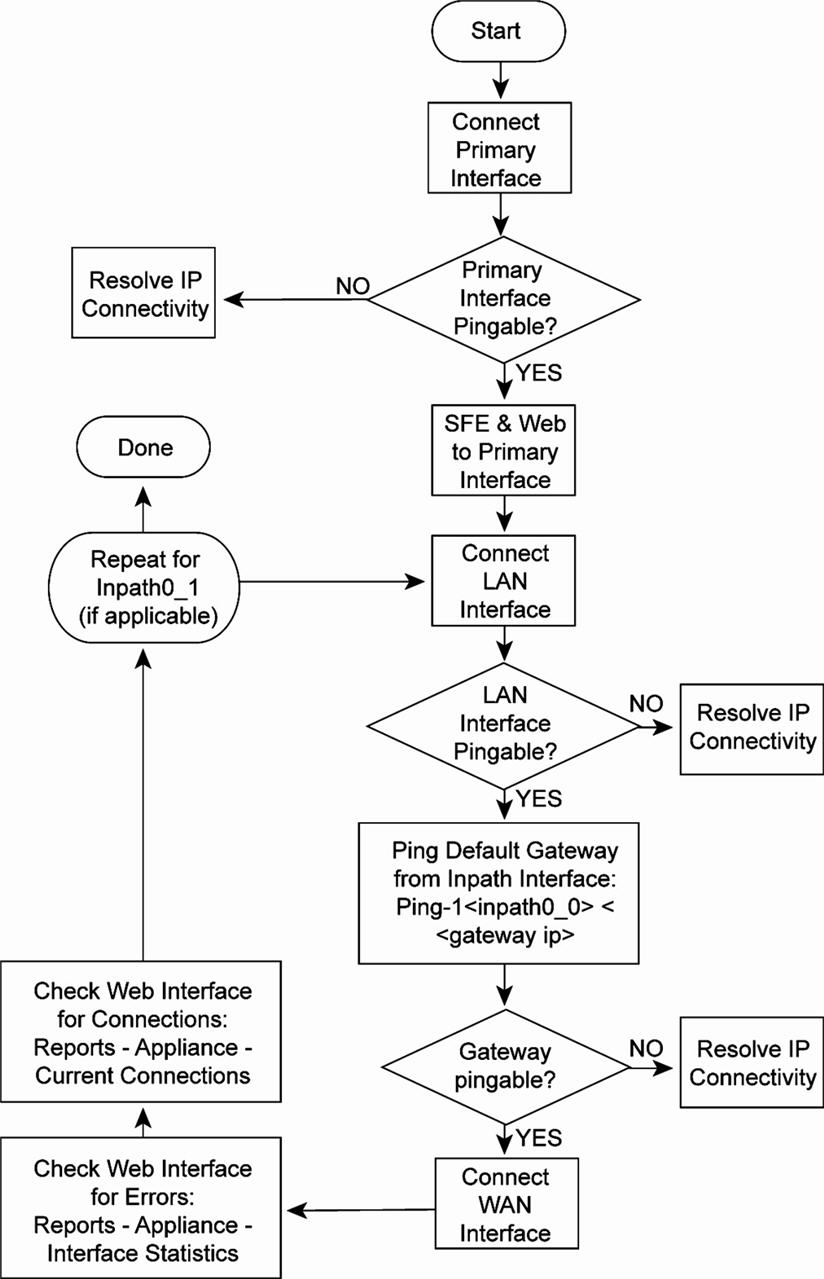
Connecting to the Management Console
After you configure the Edge appliance, you can check and modify your configuration settings and view performance reports and system logs in the Management Console. You can connect to the Management Console through any supported web browser.
To connect to the Management Console, you must know the host, domain, and administrator password that you assigned in the configuration wizard.
Cookies and JavaScript must be enabled in your web browser.
Before you begin, clear your browser cache and cookies to ensure the user interface displays correctly.
To connect to the Management Console
1. Specify the URL for the Management Console in the location box of your web browser:
<protocol>://<host>.<domain>
The <protocol> variable is http or https. HTTPS uses the Secure Socket Layer (SSL) protocol to ensure a secure environment. When you connect using HTTPS, the system prompts you to inspect and verify the SSL certificate. This is a self-signed certificate that provides encrypted web connections to the Management Console. The system re-creates the certificate when you change the appliance hostname or when the certificate expires.
The secure vault does not protect the self-signed certificate used with HTTPS connections.
The <host> variable s the hostname you assigned to the Edge appliance primary interface in the configuration wizard. If your DNS server maps that IP address to a name, you can specify the DNS name.
The <domain> variable is the full domain name for the appliance.
Alternatively, you can specify the IP address instead of the host and domain name.
The Management Console appears, displaying the Sign In page.
Figure 3‑13. Sign in page

2. In the Username text box, specify the user login: admin, monitor, a login from a RADIUS or TACACS+ database, or any local accounts created using the Role-Based Accounts feature. The default login is admin.
Users with administrator (admin) privileges can configure and administer the Edge. Users with monitor (monitor) privileges can view the Edge reports and user logs and change their own password. A monitor user cannot make configuration changes.
3. In the Password text box, type the password you assigned in the configuration wizard of the Edge appliance. (The default administrator password for the Edge is password.)
4. Click Sign In to display the Dashboard.
Verifying WAN optimization
Perform this procedure to verify that you have properly configured the Edge appliance.
To verify optimization
1. Choose Optimization > Reports: Bandwidth Optimization in the Management Console to verify optimization.
2. Map a remote drive on a client machine.
3. Drag and drop a 1-MB file from the client to the remote server.
Ensure that the server is located across the WAN.
4. Drag and drop the 1-MB file again.
Performance improves significantly.
Checking for speed and duplex errors
If you selected autonegotiation (auto) for your in-path and primary interfaces, you must ensure that the Edge appliance negotiated the speed and duplex at the rate your devices expect. For example, ensure settings are auto on the LAN and WAN and 100 FULL on the LAN and WAN. You can verify your speed and duplex settings Inpath0_0 page or Base Interfaces page of the Management Console. Choose Configure > Networking: Inpath0_0 or Networking > Networking: Base Interfaces.
To check for speed and duplex errors
1. In the Management Console, choose Administration > Diagnostics: System Logs to display the System Logs page.
2. Check the system logs for duplex or speed errors.
3. Choose Networking > Reports: Current Connections page.
4. Check for duplex and speed errors.
If you find errors, change the speed and duplex settings on your LAN and WAN interface in the Configure > Networking: Inpath 0_0 page.
Next steps
This table summarizes the next steps you should take to configure the Edge appliance.
Task | Reference |
If you are using a SteelFusion Core for storage, you should configure and connect it before running the Hypervisor Installer. A SteelFusion Core allows you to access remote storage at your data center and make that storage available to your hypervisor. | Choose Storage > Storage Edge Configuration. For details, see the SteelFusion Edge User Guide. |
Set up the hypervisor using the Hypervisor Installer. The Installer guides you through the initial configuration of the hypervisor. After you run the Installer, you can customize the hypervisor password. You can also monitor the current status and resource allocation from the Installer. | Choose Virtualization > Hypervisor: Installer. For details, see the SteelFusion Edge User Guide. |
Connect the SteelFusion Edge to the SteelFusion Core. You can also optionally connect the Edge to another active Edge as a standby peer for high availability. | Choose Storage > Storage Edge Configuration. For details, see the SteelFusion Edge User Guide. |
Configure networking and optimization features. | For details, see the SteelFusion Edge User Guide. |














